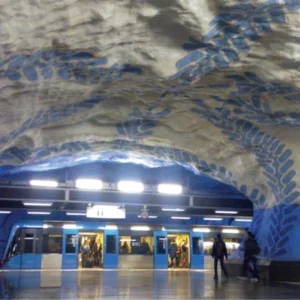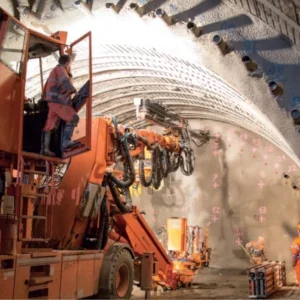Located in northeast Asia, 70 per cent of Korea is mountainous. Typical rock types are granite and granitic gneiss, though limestone and other complex sedimentary rocks are found in southern part of the country. The granite and granitic gneiss are hard with the major horizontal stress in the rock mass in the east-west direction.
Korea’s first railway tunnel was constructed in 1905, and today the total length of conventional railway tunnels is 356km—about 7.8 per cent of the country’s railways. The start of high speed-rail has brought about a renaissance of the railway industry in Korea. Along the high-speed rail route, tunnels total 191km, which is about 46 per cent of the line. Underground structures are also widely used for oil and gas storage (28km), food storage caverns, pumped storage power plants (15km), road tunnels (339km), water supply tunnels (145km), electrical power cable tunnels (339km), telecommunication tunnels (267km) and multi-purpose utility tunnels (87km).
Underground food storage
In Korea, the total capacity of on-going refrigerating facilities was reported to be 600,000t for food storage, which has been increasing 11 per cent annually. The total annual consumption of electricity for keeping food storage tanks cool is reported to be as high as 475,000MWh. Because of the high electrical load during the summer, more and larger capacity power plants will be required. The use of underground storage caverns has been suggested as an alternative.
The test site of a pilot plant was located within the premises of Korea Institute of Geoscience & Mineral Resources, which has a granite base rock type. The total area of the pilot plant is 350sqm with two rooms for food storage (operating temperatures of -25 to 0 degrees C), one room housing the cooling system and another room serving as a monitoring laboratory. Each test room was located 10m below the surface with dimensions of 4.5m to 7m wide, 3m high and 8m to 12m long.
Two kinds of fruit—pears and apples—were selected because their prices vary depending on the availablity of supply in certain seasons. For the quantitative comparison, some indices representing the quality of fruit, such as moisture content and total acid, were selected. This study showed that using underground storage with a cooling system is best for keeping the fruit in good condition. This test run was successful for obtaining real behavior of an underground food storage cavern.
Based on the above test results, the first commercial underground food storage facility was constructed 30m to 70m deep in Gonjiam area gneiss in December 1997. The facility consisted of four cold caverns, two refrigerating rooms 12m wide by 8m high by 50m long and two chilling rooms 12m wide by 10m high by 60m long. Total area of the storage facility is 3,423sqm with a storage capacity of 4,700Mt. The cost of civil construction and cavern excavation was USD 3.28M. The facility operates at a temperature of -22 degrees C. The results show that the minimum storage capacity should be more than 20,000Mt to be more economical than surface facilities.
Underground oil and gas storage
Korea is the fourth largest oil and gas importer in the world. Since the first large underground caverns for storing crude oil were built in 1985—the first with a capacity of 1.5M barrels—10 more caverns for oil and gas storage have been constructed. In 1994 another extended cavern with similar capacity was built near the first one. In 1984 an (liquefied petroleum gas) LPG storage cavern containing pressurized butane and propane was brought into service in Yeosu. Since then five more LPG storage caverns were built in Ulsan, Pyongtaek and Incheon. There are four commercial storage sites and five strategic storage sites. Table 1 shows crude oil and LPG storage caverns.
The Yeosu crude oil storage facility has the largest storage capacity in the world. Liquefied Natural Gas (LNG) storage in rock caverns has not yet been commercialized in the world because of the technical challenges in sealing LNG at extremely low temperatures (-162 degrees C). A Korean company is developing technology for storing LNG in hard rock caverns equipped with containment systems and concrete lining in a joint venture with French companies. When LNG is stored in lined, rock caverns, the formation of an ICE-ring from the extremely low temperature of LNG can be a natural barrier in the containment system. In order to implement this concept (figure 1), a drainage system should be dedicated to the conceptual design and testing program. The validity of the design is being tested at an LNG pilot cavern at the Korean Institute of Geoscience & Mineral Resources. The LNG pilot is located in an existing rock cavern where, within a 4m wide by 4m high by 10m long space, reinforced concrete was cast in place between rock and a containment system. The pilot plant was commissioned at the end of 2003 after one year of civil works, piping and instrumentation. Since January 2004 the plant has been operating using liquefied nitrogen.
Pumped storage power plant
In Korea, pumped storage power plants usually consist of intake tunnels, headrace tunnels, surge chambers, underground powerhouse, penstock tunnels, tailrace tunnels and cable tunnels. The underground powerhouses have the largest cross sectional area. Penstock tunnels that are under high water pressure require the most sophisticated technology to ensure stability. Chongpyong pumped storage power plant, the first one constructed in Korea, started service in 1980. Table 2 shows the current situation of the pumped storage power plants in Korea.
Subway construction projects
In Seoul, a network of 337km of subway lines has been open to public since the first subway in 1974. Until the introduction of NATM in 1980 the conventional method using steel support had been used. As shown in Table 3 currently six major cities have subway systems.
Seoul, the capital city, has more than 2.9M automotive vehicles, which increases annually by about 200,000. Seoul has a subway network of eight lines in operation and one line under construction. The system is well connected with the Korean National Railways.
In 1990 TBMs were introduced, and recently shield TBMs were used for subway tunnels. `To cross rivers and streams construction methods using TBMs or cut-and-cover with cofferdams have been used. In the cases of the sufficient overburden under the riverbed the bored tunnelling method was used, while in cases of the shallow overburden the cut-and-cover method was used. Unlike the previous method of crossing the Han River by the viaduct, a section of Line Five connects the Yoido and Mapo by a 1,280m tunnel beneath the riverbed.
In 1996 the excavation of two parallel tunnels 20-30m beneath the riverbed was completed. A manmade island was built in the middle of the route. The main rock type of the tunnel was banded gneiss. The rock mass was in poor condition revealing weathered and fractured zones along the discontinuities. To strengthen the rock mass and to decrease the water inflow prior to face advancing, the ground within 7m around the tunnel was grouted.
The Bundang subway tunnel that passes beneath the Han riverbed was constructed. The average rock cover is 23m and the total length of the tunnel is 1,270m. It took 18 months for the completion of the tunnel. The length of ground section constructed by drill and blast is 380.5m and the length of the river-bed passing section constructed by an EPB TBM is 845.5m. The structures of tunnel include two ventilating openings and two shelter connection pits. The use of EPB type shield TBM increases stability and workability during digging of the fractured zone and hard rock mass. The disaster prevention system consists of water leakage sensing systems, water protection gates, pumping systems and fire protection.
Railway tunnels
In 1905 the first railway tunnel was built. Today the total length of railway tunnels is 356km, with the longest running for 6.1km. The most interesting project is the Solan tunnel, which has a length of 16.3km and will be the longest tunnel in Korea. A special loop shape has been employed to overcome abrupt gradient changes. The tunnel must run through fractured zones of limestone, large faults and abandoned coal mines. High-speed rail tunnels are both in service and partly under construction, comprising 191km, or 46 percent of the alignment’s total length. There are a total of 80 tunnels along the route with nine tunnels more than 5km long. The longest tunnel is 18.5km. As of April 2004, Korea has been on par with France, Japan, Germany and Spain, and entered into the super high-speed train era operating at speeds of 300km per hour. The double-track tunnel internal cross-sectional area of 107sqm is based on a design speed of 350km/h. NATM has been used for mountain tunnels and TBMs for the tunnels crossing beneath rivers. The cut-and-cover method is only used for tunnels relatively close to the ground surface or in various situations where the NATM or TBM cannot be applied effectively and economically.
Road tunnels
Korean roads are classified into several types: national expressways, national highways, provincial roads, city roads and country roads. Tables 4 and 5 show road tunnels in Korea that are in use or under construction. The longest road tunnel is the Juk-Ryeoung Tunnel, which is 11.6m wide, 7.2m high and 4.6km long.
Since the 1980s NATM has been used as a tunnelling method. There are also several cases in which TBMs were adopted for road tunnel excavation. Between 1927 and 1932 the Chungmu subsea road tunnel was constructed by cut-and-cover. The subsea tunnel is 5m wide, 3.5m high and 483m long. The 3.2km long Busan-Geoje immersed tunnel, now under construction in Korea, will be the deepest tunnel built using the concrete segmental immersed tube system. The immersed tunnel is constructed as a concrete tunnel and is connecting two artificial islands containing service buildings: one at the Jungjuk/Daejuk Island and one at the Gaduk Island.
Another 6.9km long subsea tunneling work will be started on the coast of Boryong city later this year. The tunnel has its deepest point 34m below sea level and a rock overburden of over 40m. The ground is made up of granite and schist. The main tunnel is 11.9m wide and 8.3m high. The escape tunnel is 6.4m wide and 5.5m high for cars, while 3.6m wide and 4.1m high for passengers. The tunnel will be excavated by drill and blast.
Other underground facilities
Underground space is widely used in Korea for water supply tunnels (145km), multi-purpose utility tunnels (87km), military bunkers, five research laboratories, car parks, 70 shopping malls, five mine museums, five wine shops and 10 mushroom farms. Ultra-long subsea tunnels are being considered, such as a link from Korea to Japan and Korea to China. There are three routes for Korea-Japan subsea tunnel (table 6 and figure 2). Four routes have been considered for a Korea-China subsea tunnel that would be constructed beneath the Yellow Sea, which has and average depth of 40m and a maximum of 76m.
Conclusion
Korea has many world-scale underground structures and many large projects are in progress. Despite the steady expansion of its infrastructure, rapid industrial development and population growth in urban areas still create many problems such as traffic congestion and environmental concerns. Continuous development of the underground space in the future is expected to resolve some of these problems.
Figure 1, concept of LNG storage lined rock cavern Figure 2, Korea-Japan subsea tunnel routes Table 1: Crude oil and LPG storage caverns Table 2: Pumped storage power plants Table 3: Metro systems Table 4: Total length of road tunnels Table 5: Number of road tunnels Table 6: Korea-Japan subsea tunnel option






